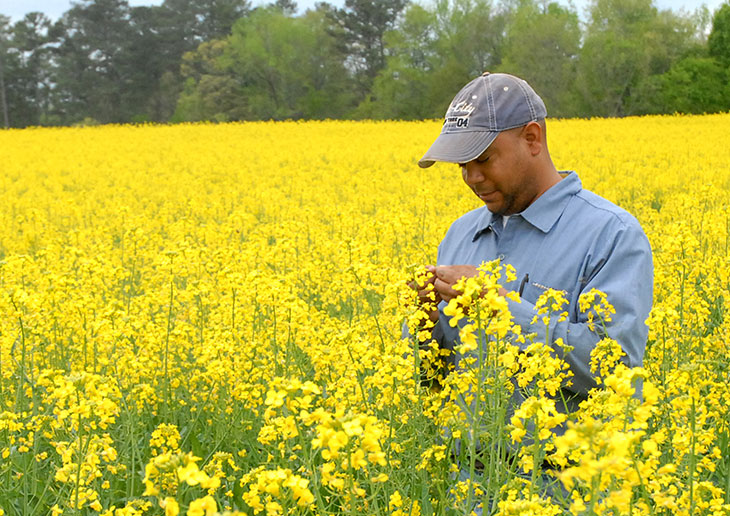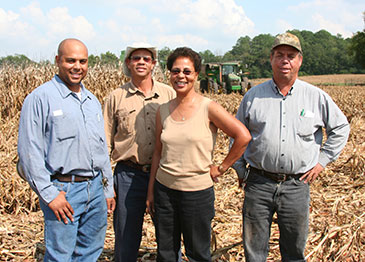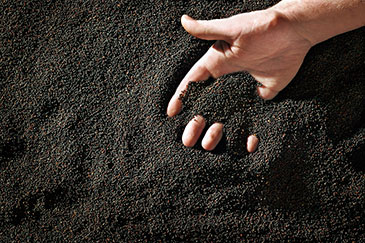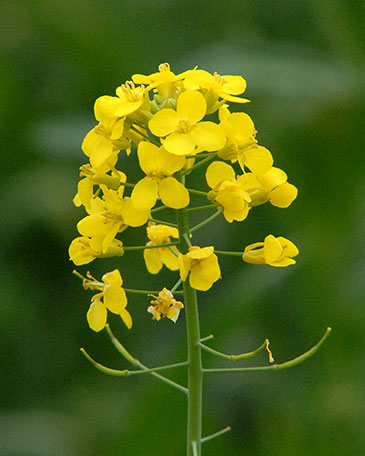It’s been 28 years since Bill Bridgeforth received his bachelor’s degree in soil science from Alabama A&M University, but the Tanner, Ala., farmer still bleeds maroon for his alma mater.
Thus, when researchers at the university asked Bridgeforth and his family to grow an experimental crop of canola last year to help determine its potential for north Alabama, the family didn’t hesitate — they planted 500 acres of the yellow-flowered oilseed crop, which is traditionally grown in cold climates.
"We grew it because Alabama A&M asked us to — and we bend over backwards to help them," says Bridgeforth, a fifth-generation farmer.

Lamont Bridgeforth examines a flowerhead in his family's first canola crop. He was responsible for managing the crop, which generated above-average profits. Alabama A&M plant breeders are developing new early-maturing lines of canola.
Photo by Kim Rynders/The News Courier
Double the Revenue
The results were definitely worth the effort: The canola returned double the revenue that the family would have earned from wheat grown on the same land.
More importantly, though, Bridgeforth says the results confirm his belief that canola might become an alternate crop for north Alabama farmers and could even fuel a local biodiesel industry.
As an edible oil, canola is growing in popularity because of its health benefits, including its zero trans-fat content. When crushed, the tiny seed yields 40 percent oil; the leftover meal is used in poultry and livestock feed.
New Varieties for Warmer Climates
The vast majority of U.S. canola production occurs in North Dakota and Minnesota, which border the western Canadian prairies, where canola was developed. But the crop is gradually making its way south, as new varieties are being developed. Acreage in the United States increased from virtually zero in 1989 to 1.2 million acres in 2008. Kansas, Oklahoma and, to a lesser extent, Arkansas, have added significant canola acreage recently.
In the past, older varieties of canola were grown in Alabama, with only limited success, says Bridgeforth. His results, on the other hand, exceeded his expectations.
Bushels per Acre
"We were told we could expect 50- to 70-bushel yields and sell it for $12 (a bushel)," says Bridgeforth, "and we ended up averaging 60 to 62 bushels, and sold it for $12.50." The Bridgeforths’ break-even for the crop was 35 bushels per acre. Wheat, in comparison, was selling for $4 per bushel when they first considered growing canola.

From leg, the Bridgeforths are Lamont, Bill, Olivia Sims and Greg. Their family has farmed near Athens, Ala., for more than 100 years.
Photo by Janet Hunter
For Bridgeforth Farms, winter canola is attractive for more reasons than price. "You farm it just about like wheat, and the costs are in the same ballpark," says Bridgeforth. "It uses just a little more fertilizer than wheat, but less herbicide, and it responds well to micronutrients." The Bridgeforths were able to plant and harvest the crop with their existing equipment.
Like wheat, it requires a period of winter dormancy. However, canola planting time in north Alabama is critical: too early, and it’s subject to winter freeze; too late and it won’t develop a good root system. The Bridgeforths planted in late September 2007 and harvested in late May 2008.
Good Crop Rotation Choice
Bridgeforth Farms employs six family members – Bill; his sons, Carlton and Kyle; his brother, Greg; his sister, Olivia Sims; and Greg’s son, Lamont, who supervises the canola operation.
They are excited about the way that canola could fit into the crop rotation on their 5,500-acre farming operation, which spans three counties. They plan to double-crop canola behind soybeans, and if they can advance their harvest date to early May, they could double-crop with cotton, too.
Biodiesel Firm Seeks Growers
But what excites Bridgeforth and some local agriculture and business leaders most is the possibility of growing canola for biodiesel production — in particular for local on-farm use. Last May, more than 300 people — including politicians, crop scientists, industry leaders, farmers and government representatives — attended a canola field day at Bridgeforth Farms to learn more about the crop.
"We had a lot of farmers here because they are interested in an alternative crop," says Bridgeforth. Due to its relatively high oil content, he says canola would make a good feedstock for biodiesel.
He envisions a time when farmers will be able to use biodiesel produced from their own canola crops. "If we could crush it and make food-grade vegetable oil, and then get it back and make it into diesel, that would be a wonderful thing," he says.
Homegrown Energy
And that just might happen. He is part of a group of engineers, businessmen and farmers interested in forming a cooperative to pursue biodiesel opportunities. "Their idea is to sell the fresh canola oil for food, and then take used canola cooking oil and let it become the source of biodiesel," says Alabama A&M’s Dr. Ernst Cebert.
The Bridgeforths contracted their 2008 canola crop with a Georgia oilseed crushing firm, AgStrong LLC, which plans to build a canola and sunflower crushing plant in Tanner in 2009. North Alabama Biodiesel, based in Florence, Ala., is interested in developing an oilseed crushing facility just across the border in Tennessee. The organizations collaborated with Alabama A&M to organize the field day.
"What they were trying to do was get a commitment from farmers in this area to grow canola," Bridgeforth explains.
"When the university asked the Bridgeforths to test this crop, they definitely asked the right farmers," says Jason Thomas, Athens branch manager at the Federal Land Bank of North Alabama. "They are a very progressive farming family. We are proud to have been their lender for three generations."
Cebert reports that north Alabama farmers planted at least 3,000 acres of canola this fall for harvest in 2009.
As for Bridgeforth, no one had to convince him and his family to grow canola again — they planted another 500 acres this fall. "Canola is a viable crop for this area," he claims.
What Is Canola?
History
Canola is an oilseed that is a genetic variation of rapeseed. It is related to turnip, cabbage, mustard and many other vegetables. Canola was developed in the 1970s by Canadian plant breeders, who used traditional plant-breeding methods — not genetic engineering — to breed out the undesirable components of rapeseed, namely erucic acid and glucosinolates.

Courtesy of the Canola Council of Canada
To distinguish the crop from rapeseed, which is high in erucic acid and has certain other differing properties, it was given the name canola, which stands for Canadian oil, low acid. "Can" refers to Canadian, and "ola" was derived from the first letters of the other three words.
Health and Cooking Properties
Canola oil is considered one of the healthiest cooking oils on the market. It is:

Kim Rynders/The News Courier
- The lowest in saturated fat of any commonly consumed vegetable oil;
- Rich in mono-unsaturated fats that have been shown to reduce blood cholesterol levels;
- A source of moderate amounts of essential polyunsaturated fats;
- Free of cholesterol and trans fat; and
- A good source of the omega-3 fatty acid, alpha-linoleic acid, an essential nutrient that may play a valuable role in heart health.